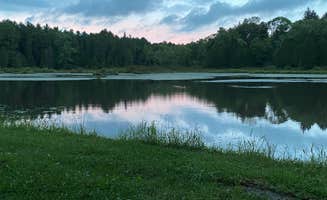Dispersed camping near Java Center, New York provides primitive outdoor experiences within several state forests across Allegany and Livingston counties. These free or low-cost sites typically sit at elevations between 1,600-2,200 feet, creating moderate temperature variations between day and night even during summer months. Most rustic sites in this region experience seasonal road closures after significant snowfall, generally from late November through early April.
What to do
Wildlife observation opportunities: Palmers Pond State Forest features excellent beaver watching from shoreline sites. As one visitor noted, "Lots of beavers to watch throughout the day" at the pond sites, which offer unobstructed views of their activity patterns, particularly at dawn and dusk.
Creek-side relaxation: Camp Seneca provides designated sites alongside flowing water. A camper explained, "We picked the biggest site next to the creek. The tree canopy over our site was dense enough that we did not get very wet when it rains." The sound of running water creates natural white noise for sleeping.
Fishing access: The pond areas offer basic shore fishing for warm-water species. According to one camper at Palmers Pond State Forest, "No electricity or water hook ups, very secluded, has a pond to fish in, by far my most favorite place to camp." Some visitors bring small portable watercraft for better fishing access.
What campers like
Tree cover and natural shade: Many sites feature established canopy protection. At Camp Seneca, visitors appreciate that "the tree canopy over our site was dense enough that we did not get very wet when it rains," providing natural shelter during summer showers.
Low traffic and solitude: The remote nature of these sites minimizes crowds. One camper observed, "We came in to the area on a Monday and this camp was completely empty. We had a few hikers come through and one other camper that chose not to stay." This provides genuine seclusion for rustic camping near Java Center, New York.
Clear navigation guidance: Fellow campers provide vital access information. A Palmers Pond visitor advised, "The directions took us to a dead end like the other reviews stated. Do not take Palmers pond road. When you get off of Interstate 86 you will want to take turnpike rd to south road." This local knowledge prevents navigation frustrations.
What you should know
Route planning requirements: Approaching these remote sites requires specific access routes. One camper at Palmers Pond State Forest warned, "⚠️Side note TAKE WEST ALMOND road as the other road is blocked off⚠️" highlighting the importance of approach direction to avoid impassable roads.
Maintenance limitations: State forest properties receive minimal upkeep. At Ossian State Forest, a recent visitor reported, "I've camped here in the past and it was really nice. Obvious that the area has not been tended to in some time. Only a couple of the primitive sites are accessible and most of the trails are choked with growth or blocked with fallen trees."
Water availability planning: No drinking water exists at any sites. Pack sufficient water supplies for your entire stay, particularly during hot summer months when dehydration risks increase. Nearby streams and ponds require filtration or treatment before consumption.
Tips for camping with families
Site selection strategy: Choose established areas with natural boundaries. At Palmers Pond State Forest, families appreciate that "if the lake spots are busy check the woods, there are a bunch more nice spots. dispersed free LNT style." This provides options when prime waterfront locations are occupied.
Weather considerations: The tree cover provides significant protection. One camper mentioned, "The tree canopy over our site was dense enough that we did not get very wet when it rains." This natural shelter helps during brief summer showers, though persistent rain can eventually penetrate.
Seasonal timing: Spring visits require preparation for mud. At Boyce State Forest, a visitor warned, "Trail was more of a stream than a trail. You'll spend more time beside the trail then actually on it... Would recommend to come in dryer season or to bring rubber boots." Late summer provides drier conditions.
Tips from RVers
Access limitations: Most sites accommodate smaller rigs only. For easier sites, a camper noted, "The road was gravel but pretty easy to drive. I found one of the first spots and was very comfortable."
Leveling challenges: Prepare for uneven parking at most sites. At Boyce State Forest, visitors report, "Campsite was clean and came with an 'air conditioned loo'. Lots of room for tents, however, most sites are not flat." Bring leveling blocks and chocks for stabilization.
Road condition awareness: Forest roads deteriorate seasonally. After visiting Ossian State Forest, one camper reported, "The roads are a little rough also. Hopefully it will get some attention in the near future." Spring thaws create the most challenging conditions for vehicle access, particularly for longer wheelbases.



